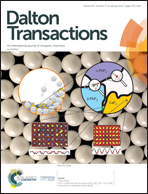Stabilisation of copper(i) polypyridyl complexes toward aerobic oxidation by zinc(ii) in combination with acetate anions: a facile approach and its application in ascorbic acid sensing in aqueous solution†
Abstract
A new and facile approach to stabilise copper(I) complexes in aqueous solution by the addition of zinc(II) ions in combination with acetate ions (OAc−) was demonstrated. This stability enhancement toward the aerobic oxidation of copper(I) species was investigated by various techniques including UV-vis spectroscopy, 1H-NMR, FT-IR, and ESI-MS. Our experimental results together with DFT calculations led to a proposed structure of [(adpa)Cu-OAc-Zn(OAc)(H2O)2]+/2+. It was also postulated that zinc(II) with its Lewis acidity may attract electrons from the Cu centre through the bridging ligands (OAc−), resulting in the lower reactivity of Cu(I) with O2. In addition, this strategy was shown to be applicable to ascorbic acid detection by monitoring a change in the redox states of copper complexes using fluorescence spectroscopy. Moreover, it was demonstrated that the method was sensitive and accurate for the quantitative analysis of ascorbic acid in vitamin C tablets.



 Please wait while we load your content...
Please wait while we load your content...